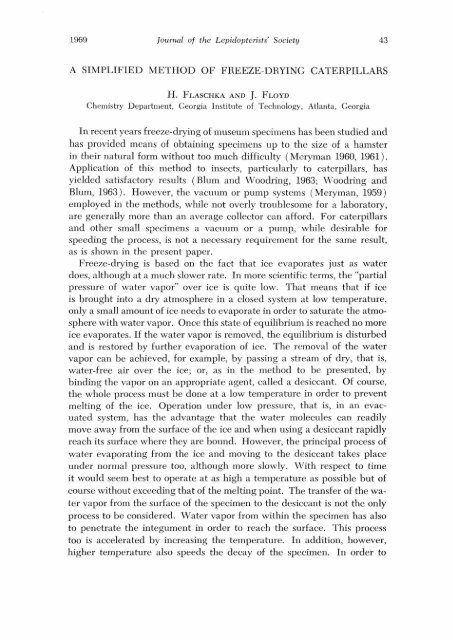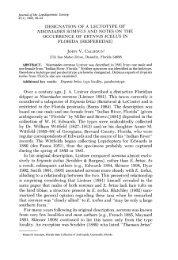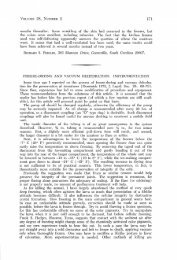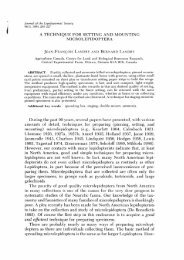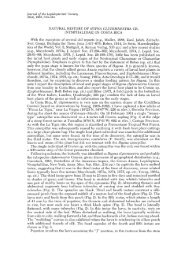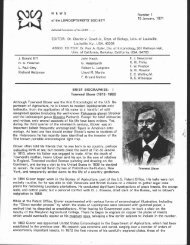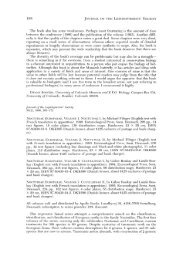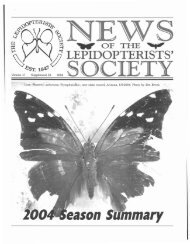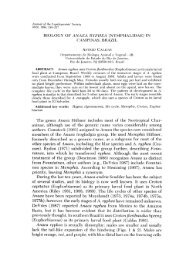A SIMPLIFIED METHOD OF FREEZE-DRYING CATERPILLARS In ...
A SIMPLIFIED METHOD OF FREEZE-DRYING CATERPILLARS In ...
A SIMPLIFIED METHOD OF FREEZE-DRYING CATERPILLARS In ...
Create successful ePaper yourself
Turn your PDF publications into a flip-book with our unique Google optimized e-Paper software.
44 FLASCHKA AND FLOYD: Freeze-drying larvae Vol. 23, no. 1avoid the latter, a temperature below the optimum for speedy drying mustbe maintained. Such considerations are of mere theoretical interest sincethe temperature in the ice cube compartment is preset and in the freezervariations are possible only within a limited range for the collectorworking at home.With this admittedly sketchy discussion of the underlying principle itwill be easily understood how freeze-drying of a caterpillar is effected.The animal is brought into a container together with some desiccant. Thecontainer is then closed air-tight, stored in a deep freezer or in the ice cubecompartment of a refrigerator and left there until essentially all the waterfrom the frozen specimen has moved to the desiccant. The time requiredfor this process predominantly depends on the size of the specimen andthe temperature (see above ). There is no formula established to allowan exact calculation or even a rough estimation of this time, and eachexperimentor will have to gain his own experience. But some idea maybe obtained from the series of experiments described below.The containers present no problem. Any tightly closing screw cap glassor plastic container is suitable provided its size fits the dimensions ofthe specimen.Desiccants suitable for the purpose exist in large numbers. We considerSilicagel as the most practical one. It is readily obtained at a lowprice from a supply house for chemicals. Silica gel is sold as granules of1-2 mm diameter and in dry state is of deep blue color. This color isdue to an impregnation with a salt that changes its color to pink when wet.Thus the color of the material readily indicates exhaustion. The pinkSilicagel no longer has water-absorbing properties and consequently thecharge in the container must be renewed. Silicagel has another enormousadvantage, namely, it can readily be regenerated by mere warming. Acollector who has no access to special drying ovens can perform this taskby simply placing the pink Silicagel into a pot or frying pan and keepingit at moderate heat, while occasionally stirring it with a piece of wood ora spoon. The heating may be effected on the burner of a range or, preferably,because it is milder and more uniform, in an oven. No harmfulcomponents are released. When the mass has completely regained theblue color, it is placed back into the storage bottle, kept there tightlyclosed and is ready for reuse. Extreme heat should be avoided during thedrying procedure because it may cause cracking of the particles andrender them less effective in their drying power. As a rule of thumb thelowest temperature that achieves blueing should be used.During experimentation over more than two seasons some experiencehas been acquired, and a few points of interest may be discussed, but
1969 Journal of the Lepidopterists' Society 45anyone applying the method may find ways of improvement in onerespect or another, A caterpillar that is sluggish and does not movearound, e.g., a saddle-back caterpillar, can be brought with the leaf onwhich it sits directly into the desiccant-containing jar, which after closingis placed directly into the freezer, The animal dies from undercooling withhardly any movement and the drying process starts to take place.Species that move about can also be treated in this way but in manycases will curl or contract before they die and will then not show theirnatural position or form. <strong>In</strong> such an event it is often helpful to put thecaterpillar in a container without desiccant and to place it in a refrigerator(not freezer! ). At the reduced temperature the animal commonly ceasesmoving and while still alive comes to rest in a natural position. Oncethis state is reached the container is transferred to the deep frost compartmentor freezer where the caterpillar solidifies in the desired position.When thoroughly frozen (say, overnight) the specimen is transferred tothe desiccant-containing jar. It is advisable to make this transfer asrapidly as possible in order to prevent large amounts of moisture fromcondensing on the specimen. This condensed water, of course, must alsobe removed and more drying time is required and more desiccant is usedup. <strong>In</strong> this modification of the method it is also advisable to have thedesiccant-containing jar cooled before introducing the specimen. Thereason for this is that the outside portion of the specimen in contact withthe desiccants may thaw sufficiently to become flat or get dells impressedfrom the granules of the Silica gel. Of course such distortions once thespecimen is dried cannot be repaired.The final method is to kill the caterpillar before subjecting it to freezedryingby dropping it into boiling water. After removal from the waterit is essential to place the specimen on a blotting paper and to allowevaporation of the adherent water. Hairy specimens after such treatmentshow the hairs completely entangled. But natural position of the hairs canreadily be restored by brushing with a soft brush after complete outsidedryness has been reached. <strong>In</strong> order to avoid dells the specimen shouldnot be brought directly into the Silicagel but rather be placed on a pieceof paper or thin cardboard. After arranging the specimen in the desiredposition, the jar is closed and carefully placed into the freezer.It is advisable to inspect the jars in the freezer from time to time andobserve the progressive expansion of the pink layer in the Silica gel. Ifits major portion is pink the desiccant should be renewed. <strong>In</strong> order toavoid thawing of the specimen, the following procedure is recommended.A jar with new desiccant is placed into the freezer and allowed to cool.Then this jar and the one containing the specimen and the exhausted
48 FLASCHKA AND FLOYD: Freeze-drying larvae Vol. 23, no. 1the simplest and safest way is to place the specimen into the desiccantcontainingjar and allow to stand in the freezer for about 3-6 monthsdepending on the size of the caterpillar. The well-known tent caterpillarMalacosoma americana should readily serve as a guide. The specimensused in the experiments were in their last ins tar and about one inch inlength.LITERATURE CITEDBLUM, M. S., & J. P. WOODRING, 1963. Preservation of im:ect larvae by vacuumdehydration. J. Kansas Ent. Soc., 36:96--101.MERYMAN, H. T., 1959. Sublimation freeze-drying without vacuum. Science, 130:628-629.1960. The preparation of biological museum specimens by freeze-drying. Curator,5-19.1961. The preparation of biological museum specimens by freeze-drying: II<strong>In</strong>strumentation. Curator, 4: 153-174.WOODRING, J. P., & M. S. BLUM, 1963. Freeze-drying of spiders and immatureinsects. Ann. Ent. Soc. Amer., 56: 138-141.A NEW FOODPLANT FOR EUPHYDRYAS PHAETON( NYMPHALIDAE )On July 17, 1967, a wet meadow near Newton, New Jer:;ey, was visited whereMelitaea harrisii Scudder and Euphydryas phaeton (Drury) were plentiful. WheneverI find E. phaeton flying, I look them over first for variations, then try to locate thefooclplant, turtlehead (Chelone glabra Linllaeus), to find the larva of Papaipemanepheleptena Dyar (Noctuidae) boring in the root of this plant. This meadow andseveral others in the neighborhood were investigated thoroughly, but no turtleheadcould be found. Later, a larva of E. phaeton was found on a plant with whiteflowers, and further investigation enabled collection of a dozen larvae of all sizesin the space of 15 minutes. The caterpillars were sitting on the top of either leavesor flowers where they could be easily detected. This plant, which was growing inthis meadow by the hundreds, was identified as eastern pentstemon (Pentstemonhirsutus Linnaeus), or hairy beard-tongue. It grows from one to three feet high,with the flowers one inch wide. The range of this plant is said to be the eastern half ofthe U.S.A. and adjacent Canada. Like turtlehead, it belongs to the snapdragonfamily, Scrophulariaceae.Turtlehead being extremely rare in the New Jersey area, larvae of E. plwetonshould therefore be expected on pentstemon.JOSEPH MULLER, R.D. 1, Lebanon, New Jersey.


